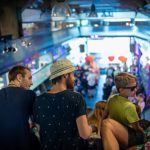Text: Cosmina Goagea
Photo: Joachim Engelstad
A large city is faster than people, and architecture projects are slower than technology. Obviously, current economy gives rise to a great social injustice. All kinds of emergencies condense time so that crisis becomes the norm, the world is increasingly more busy and hotter day after day. A generation of people who are not working for a remote future, but for one that is already here, who are trying to change, on the fly, the way of city-living, the paradigm and the democracy.
The first optimistic idea was that many things were up to us, dwellers of a neighbourhood or of a city, that we could get together and solve things which would otherwise reach the public administration agenda very late or never at all. Of course, many bottom-up initiatives and projects have changed the world for the better. But it is only their support by smart urban policies that could help them to last over time. This is what the “Cities in Transition” program, for instance, started doing, by adding the community and participatory independent practices of all the European capital cities (City Makers Agenda) as an appendix to the EU Urban Agenda.
People are also speaking more of re-programming – reconsidering resources and making them work in new ways, in smart combinations that may bring innovation to the city and to the society. Very varied practices of urban regeneration give a different meaning to the huge stock of obsolete buildings or infrastructure segments, or change a critical situation by only shifting one small design detail. Urban strategist Scott Burnham is following these practices globally, through the project entitled “Reprogramming the City”. Ideas most often start from the social or creative entrepreneurship area, or that of small local communities, but they are all implemented in partnership with industrial companies and with an open-minded public administration.
It’s strange, however, the better (and more developed) a city, the less resilient it proves to be. The model where centralized control holds the city and the society in the safe, risk-free area, is in serious danger of collapsing. And then new options emerge, for which cities are real-time testing laboratories. Such a movement is Municipalism, a movement where there is a kind of role-swapping between the local administration level, and the civil society one. The administration acts in a way that used to be owned by urban activism, and the citizens’ organizations have a distinct voice in public decision-making. The Municipalist agenda is a very wide one, but is first and foremost focused on the idea of common good for the people in a certain place, despite the differences between them and everyone’s place of origin. Dedicated programs answer very specific, very local, needs, which very often belong to the most vulnerable of us. One can equal the quality of public space and the quality of democracy. An essential aspect of the movement is the so-called femininization of policies: for instance, inserting empathy and emotions as values in urban policies, or creating working opportunities to better combine the professional and the private life, or negotiating the visibility of sex workers in the public space. In a society that is increasingly polarised by fear and by all types of inequities and stereotypes, the “Fearless Towns and Cities” Municipalist platform brings together communities of people, mayors, local councillors, environmental activists, journalists, artists, researchers, and everyone else, in networks of collaboration and solidarity for a better city. Initiated in 2017 by the Barcelona en Comú organization, the platform aims to create a global Municipalist movement, which should sustain de-centralized collaborations between governmental and non-governmental organizations in various cities worldwide. This direction shows a radical change in urban policies, and a social contract that is completely different from what we know today.
*Photo: Joachim Engelstad / Design og arkitektur Norge, “Reprogramming the City” exhibition, DOGA – Oslo








